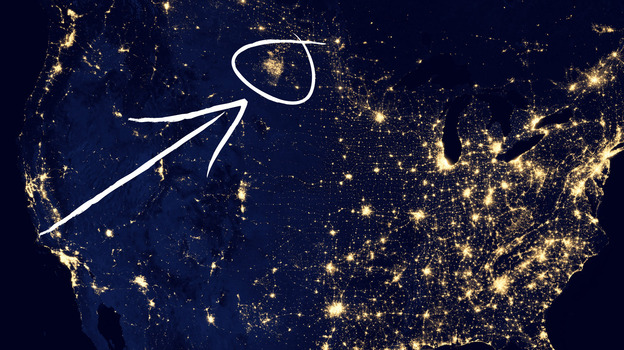Robert Krulwich, a Science Correspondent for NPR, recently noticed a bright patch of lights in North Dakota that was captured by a NASA satellite photo tour of Earth at night. Six years ago, that region was virtually dark. What changed?
“What we have here is an immense and startlingly new oil and gas field — nighttime evidence of an oil boom created by a technology called fracking. Those lights are rigs, hundreds of them, lit at night, or fiery flares of natural gas. One hundred fifty oil companies, big ones, little ones, wildcatters, have flooded this region, drilling up to eight new wells every day on what is called the Bakken formation. Altogether, they are now producing 660,000 barrels a day, double the output two years ago, so that in no time at all, North Dakota is now the second largest oil producing state in America. Only Texas produces more, and those lights are a sign that this region is now on fire … to a disturbing degree — literally” (source).
“The Bakken formation is a rock unit from the Late Devonian to Early Mississippian age occupying about 200,000 square miles (520,000 km2) of the subsurface of the Williston Basin, underlying parts of Montana, North Dakota, and Saskatchewan. The formation was initially described by geologist J.W. Nordquist in 1953. The formation is entirely in the subsurface, and has no surface outcrop. It is named after Henry Bakken, a farmer in Tioga, North Dakota who owned the land where the formation was initially discovered…New rock fracturing technology available starting in 2008 has caused a recent boom in Bakken production. By the end of 2010, oil production rates had reached 458,000 barrels (72,800 m3) per day, outstripping the capacity to ship oil out of the Bakken” (source).
While this new source of oil has improved U.S. energy security, it has its drawbacks. The boom conditions are such that North Dakota has changed from being one of the only states whose population had not grown significantly in 80 years to becoming one where the population is exploding, the current unemployment rate is the lowest in the U.S., the state budget now has a surplus, and there are still many more jobs in the local oil industry than can be filled. However, such rapid growth has negative impacts on local environments at many levels—roads are inadequate for the increased traffic, waste water treatment is a problem as sewage treatment facilities are being overwhelmed, schools and other institutions and support facilities are stressed, the price of land has skyrocketed, and there are concerns that hydraulic fracking poses major risks to ground water and air quality.
Another downside to North Dakota’s oil boom is methane pollution. According to Peter Lehner, in his blog written for the Natural Resources Defense Council, “Fracking for oil in North Dakota is so lucrative that when natural gas bubbles up alongside the oil, most oil companies simply view it as waste. It’s cheaper, in the short term, to burn the gas than it is to build the infrastructure to pipe and sell it–so they burn it. Across the North Dakota prairie, natural gas flares light up the night sky like huge torches. Every day, they burn off enough gas to heat half a million homes.” That’s more than 100 million cubic feet of natural gas, and, to make matters worse, the flared gas also releases over two million tons of carbon dioxide into the atmosphere every year, as much as 384,000 cars or a medium-size coal-fired power plant would emit (source).
“The implications of all the newfound oil deposits in North Dakota and, in fact, in other parts of the United States underlain by similar, favorable formations, are only just being understood. At a time when environmentalists are striving to move the United States to energy self-sufficiency through renewable energy sources with natural gas as a fuel to make the transition to renewables, there is concern that exploitation of vast amounts of new oil will exacerbate the carbon loading in the environment, as well as contributing to other environmental problems associated with fossil fuels” (source: Professor Ed Keller, private correspondence).
Editor’s note: Many thanks to Geography grad student Tim Niblett for suggesting this material.





